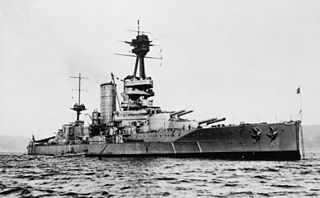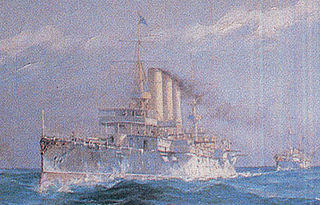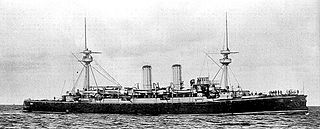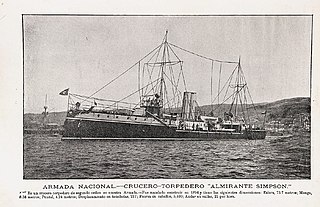
The New Orleans class of protected cruisers of the United States Navy consisted of two ships which were building for the Brazilian Navy at Elswick, near Newcastle Upon Tyne, England, by Armstrong Whitworth. The Brazilian Navy had ordered four Elswick cruisers, but had already sold the first ship during construction to Chile as Ministro Zenteno. One ship was delivered to Brazil, named Almirante Barroso. The third ship was fitting out as Amazonas, and the fourth was on order as Almirante Abreu.

The Eclipse-class cruisers were a class of nine second-class protected cruisers constructed for the Royal Navy in the mid-1890s.

HMS Andromeda was one of eight Diadem-class protected cruisers built for the Royal Navy in the 1890s. Upon completion in 1899, the ship was assigned to the Mediterranean Fleet where she helped to escort a royal yacht during its cruise through the Mediterranean Sea. After a refit, she was assigned to the China Station in 1904 and returned home three years later to be reduced to reserve. Andromeda was converted into a training ship in 1913 and remained in that role under various names until 1956. That year she was sold for scrap and broken up in Belgium, the last Pembroke-built ship still afloat.

The Blake class was a two-ship class of first-class protected cruiser built around 1890 for the Royal Navy.

HMS Aurora was one of seven Orlando-class armoured cruisers built for the Royal Navy in the mid-1880s. The ship spent a brief time in reserve before she was assigned to the Channel Squadron for two years in 1890. In 1893 Aurora became a coast guard ship in Ireland for two years before she was placed in reserve again. The ship recommissioned in 1899 for service on the China Station and some of her crew participated in the Battle of Tientsin in 1900 during the Boxer Rebellion. Aurora returned home two years later and was again reduced to reserve. She was taken out of service in 1905 and sold for scrap on 2 October 1907.

HMS Sirius was an Apollo-class cruiser of the British Royal Navy which served from 1892 to 1918 in various colonial posts such as the South and West African coastlines and off the British Isles as a hastily converted minelayer during the First World War.

HMS Adventure was the name ship of her class of two scout cruisers built for the Royal Navy during the first decade of the 20th century. For two years after being completed in 1905, the ship was in reserve. She was commissioned in mid-1907 as a flotilla leader in the Home Fleet. When the First World War began in August 1914, she was assigned to patrol the English Channel. In mid-1915 Adventure was transferred to Irish waters to serve as the flagship there. In early 1918, the ship escorted convoys to Gibraltar before being transferred to the Mediterranean at the end of the war. She returned home in mid-1919 and was paid off. Adventure was sold for scrap in early 1920.

HMS Attentive was one of two Adventure-class scout cruisers built for the Royal Navy during the first decade of the 20th century. Completed in 1905 the ship was placed in reserve until she was commissioned in 1907 as part of the Home Fleet. She then spent the next seven years moving on and off of active service in British waters. The ship sank one destroyer and damaged two others in collisions. Attentive was assigned to coastal defence duties when the First World War began in 1914, and spent most of the war assigned to the Dover Patrol. She played a minor role in the Zeebrugge Raid in early 1918 and was then assigned to escort convoys to Gibraltar. The ship was sent to the White Sea later in the year to support the unsuccessful North Russia intervention in the Russian Civil War. Attentive paid off at the end of 1918 and was sold for scrap in 1920.

There have been at least three vessels that have served with the Brazilian Navy named Almirante Barroso, after Francisco Manuel Barroso, Baron of Amazonas:

Almirante Latorre, named after Juan José Latorre, was a super-dreadnought battleship built for the Chilean Navy. It was the first of a planned two-ship class that would respond to earlier warship purchases by other South American countries. Construction began at Elswick, Newcastle upon Tyne soon after the ship was ordered in November 1911, and was approaching completion when it was bought by the United Kingdom's Royal Navy for use in the First World War. Commissioned in September 1915, it served in the Grand Fleet as HMS Canada for the duration of the war and saw action during the Battle of Jutland.

The Almirante Latorre class consisted of two super-dreadnought battleships designed by the British company Armstrong Whitworth for the Chilean Navy. They were intended to be Chile's entries to the South American dreadnought race, but both were purchased by the Royal Navy prior to completion for use in the First World War. Only one, Almirante Latorre (HMS Canada), was finished as a battleship; Almirante Cochrane (HMS Eagle), was converted to an aircraft carrier. Under their Chilean names, they honored Admirals (Almirantes) Juan José Latorre and Thomas Cochrane; they took their British names from what was then a dominion of Canada and a traditional ship name in the Royal Navy.

ARA Almirante Brown was a central battery ironclad of the Argentine Navy built in the 1880s by Samuda Brothers in London. Almirante Brown displaced 4,200 long tons (4,300 t) and had a top speed of 14 knots. The ship was protected by a belt of nine-inch (230 mm) steel-faced armor and she carried a main battery of eight breech-loading guns. She was among the first major warships in the world to use steel armor, and remained the largest vessel in the Argentine fleet for over 15 years. Almirante Brown had a peaceful career in the fleet during the 1880s and 1890s. By the 1920s, she was reduced to a coastal defense ship, and remained in service until the early 1930s. She was stricken from the naval register in November 1932 and sold for scrapping.

A naval arms race among Argentina, Brazil and Chile – the most powerful and wealthy countries in South America – began in the early twentieth century when the Brazilian government ordered three dreadnoughts, formidable battleships whose capabilities far outstripped older vessels in the world's navies.

O'Higgins was a Chilean armoured cruiser. O'Higgins was built by the British shipbuilder Armstrong to the design of Philip Watts, and served with the Chilean Navy between 1898 and 1933.

Esmeralda was developed as a custom design by naval architect Philip Watts for the Chilean Navy during the Argentine–Chilean naval arms race.

In the late nineteenth and early twentieth centuries, the South American nations of Argentina and Chile engaged in an expensive naval arms race to ensure the other would not gain supremacy in the Southern Cone.

ARA Buenos Aires was a protected cruiser of the Argentine Navy. It was built by the British shipyard of Armstrong Mitchell and Co, being launched in 1895 and completing in 1896. Buenos Aires continued in use until 1932.

The Almirante Grau class was a class of two scout cruisers built for the Peruvian Navy between 1905 and 1907. Both ships remained in service until 1958.

The Chilean cruiser Esmeralda was the first protected cruiser, a ship type named for the arched armored deck that protected its most vital areas, including its propulsion plant and magazines.

Almirante Simpson was a unique design of torpedo gunboat, built by the British shipyard Laird Brothers. Acquired by the Chilean Navy in 1895, during construction. The ship had a brief service in Chile, being transferred to the Ecuadorian Navy in 1907 and renamed Libertador Bolívar. She was the first Ecuadorian warship of the 20th century and had an important participation in the Ecuadorian Civil War of 1913–1916. After the war, the ship was retired and then sank in 1928.




















